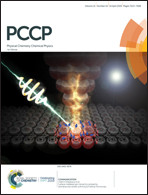Triarylamine-based hydrido-carboxylate rhenium(i) complexes as photosensitizers for dye-sensitized solar cells†
Abstract
Two new dyes based on a dinuclear rhenium complex and (E)-3-(5-(4-(bis(2′,4′-dibutoxy-[1,1′-biphenyl]-4-yl)amino)phenyl)thiophen-2-yl)-2-cyanoacrylic acid (namely D35) have been investigated as sensitizers for dye sensitized solar cells (DSSCs). Two different pyridazine ligands have been used, namely 4-pyridazine-carboxylic acid for dye 2 ([Re2(μ-H)(-D35)(CO)6(μ-pyridazine-4-COOH)]) and 4-pyridazinyl-butanoic acid for dye 3 ([Re2(μ-H)(-D35)(CO)6(μ-pyridazine-4-C3H6-COOH)]). The performances of these new dyes have been compared with those of the dye containing the bare 4-diphenylaminobenzoic acid, namely TPA, as the ancillary ligand (dye 1). Compared to dye 1, dyes 2 and 3 show an impressive tenfold increase in the absorption intensity in the range of 487–493 nm on TiO2 films, with great improvement of the light harvesting. Cyclic voltammetry experiments, performed on derivatives containing the methyl ester of the pyridazine ligands, show narrow electrochemical band gaps in the range of 1.36–1.84 eV. Solar cells with each dye have been prepared, using both iodide/triiodide and cobalt redox couples as the electrolytes, platinum or carbon as the counter electrodes, and TiO2 or SnO2 as the metal oxide photoelectrodes, respectively. The best DSSC results have been obtained using dye 3, with an overall solar-to-electric conversion efficiency of 3.5%, which greatly overcomes the previous result of 1.0% obtained for dye 1 in a not-optimized setup of the device. The performances of dye 3 are due to the presence of D35 ligand, which further suppresses the recombination of the injected electron with the electrolyte and with the oxidized state of the dye.



 Please wait while we load your content...
Please wait while we load your content...